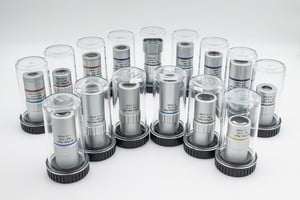Microscope Objective Lenses
Featured Product from Avantier Inc.

Types of Objectives
Based on aberration correction
- Achromatic objective lenses are the most economical objectives to produce and are designed with corrections for chromatic aberration in two wavelengths (blue and red) and spherical aberration in one (green). They typically consist of two lens doublets and a front lens. These lenses provide the best images when light is passed through a green interference filter.
- Plan achromat lenses are achromatic lenses with corrections for flat-field aberration.
- Semi-apochromat lenses, on the other hand, include several extra optical components and correct for a greater number of spherical aberrations. This enables semi-apochromat objectives to be manufactured with higher numerical aperture NA.
- Apochromats Lenses are the most sophisticated microscope objective lenses available and include the most aberration corrections. Their high resolving power means they are a good choice for research applications in which color photomicrography is required, and can be designed with a higher numerical aperture.
Based on system
- Reflective Objective Lenses are Microscope objective lenses that include two or more mirrors are called This type of objective typically boasts a long working distance and zero chromatic aberration, and is useful for FTIR spectroscopy applications.
- Refractive Objective Lenses are microscope lenses made of transparent materials like glass. They use refraction, not reflection, to focus light onto the specimen. These lenses consist of multiple lens elements that correct for optical aberrations and ensure high-quality imaging.
Based on immersion medium
- Oil-immersion Objective Lenses, while most lenses are designed to work with air between the objective and cover glass, a higher numerical aperture can sometimes be achieved with other substances such as special oil with a specific refractive index.
- Water immersion Objective Lenses use water as the immersion medium between the objective and cover glass. This allows for a higher numerical aperture, improving resolution and image quality in microscopy applications.
- Air immersion Objective Lenses are designed to work with air as the medium between the objective and cover glass. They are commonly used in standard microscopy setups and provide good resolution and image clarity.
- Glycerol immersion objective lenses utilize glycerol, a viscous liquid, as the immersion medium. Glycerol has a refractive index close to that of glass, enabling improved light collection and resolution. It is commonly used in specialized microscopy techniques where high-resolution imaging is required.
Custom Microscope Objectives Solutions – UV, NUV, VISIBLE & NIR REGION
Avantier continues to redefine precision microscopy with its cutting-edge NIR, NUV, and UV Infinity Corrected Objectives. Engineered for accuracy and clarity, these objectives elevate research and analysis across near-infrared (NIR), near-ultraviolet (NUV), and ultraviolet (UV) spectra. With advanced optical coatings, aberration correction, and infinity-corrected designs, researchers can explore samples with unmatched clarity and fidelity. These objectives are pivotal for applications ranging from material science to life sciences, enabling scientists to delve deeper into the microscopic world with confidence. Avantier once again proves its commitment to excellence by delivering tools that empower scientific discovery and innovation.
If you’re interested in acquiring in-stock Microscope Objective Lenses, please visit our ‘Stock – Microscope Objective‘ page.
Related Content
Case Study: Objective Lens for Single Atom Trapping and Imaging
Case Study: Long Working Distance Microscope Objective Lens
Case Study: High and Low Temperature Resistant 25X Objective Lens
Case Study: 20X Objective Lens & Tube Lens For Observing Blood










